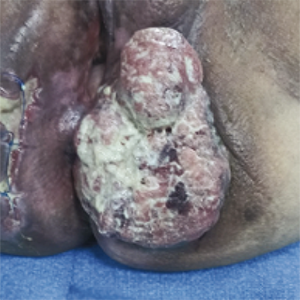Necrotizing fasciitis arising from squamous cell carcinoma of the vulva

Accepted: 9 March 2021
HTML: 48
All claims expressed in this article are solely those of the authors and do not necessarily represent those of their affiliated organizations, or those of the publisher, the editors and the reviewers. Any product that may be evaluated in this article or claim that may be made by its manufacturer is not guaranteed or endorsed by the publisher.
Necrotizing fasciitis (NF) is a devastating soft tissue infection affecting fascias and subcutaneous soft tissues. While it is associated with several risk factors, including malignancy, alcoholism, liver disease, drug use, malnutrition, diabetes, male gender and old age, few case reports in the literature describe its rare connection with genital malignancy. Vulvar squamous cell carcinoma (SCC) is the fourth most common malignancy, representing 5% of all gynaecological tumours among women. NF due to vulvar SCC is a rare complication. In this article, we present the 1991 case of a 58-year-old diabetic female patient with NF due to vulvar SCC. While surgical intervention was successful, the prognosis for vulvar SCC was poor because of late detection.
Peri M, Grassadonia A, Iezzi L, et al. A Case of Stage I Vulvar Squamous Cell Carcinoma with Early Relapse and Rapid Disease Progression. Case Rep Oncol Med 2019;2019:1018492. DOI: https://doi.org/10.1155/2019/1018492
Ueda Y, Enomoto T, Kimura T, et al. Two distinct pathways to development of squamous cell carcinoma of the vulva. J Skin Cancer 2011;2011:951250. DOI: https://doi.org/10.1155/2011/951250
Woolderink JM, de Bock GH, de Hullu JA, et al. Patterns and frequency of recurrences of squamous cell carcinoma of the vulva. Gynecol Oncol 2006;103:293-9. DOI: https://doi.org/10.1016/j.ygyno.2006.03.010
Alkatout I, Schubert M, Garbrecht N, et al. Vulvar cancer: epidemiology, clinical presentation, and management options. Int J Womens Health 2015;7:305-13. DOI: https://doi.org/10.2147/IJWH.S68979
Addison WA, Livengood CH 3rd, Hill GB, et al. Necrotizing fasciitis of vulvar origin in diabetic patients. Obstet Gynecol 1984;63:473-9. DOI: https://doi.org/10.3109/00016348409156706
Adelson MD, Miranda FR, Strumpf KB. Necrotizing fasciitis: a complication of squamous cell carcinoma of the vulva. Gynecol Oncol 1991;42:98-102. DOI: https://doi.org/10.1016/0090-8258(91)90239-2
Stephenson H, Dotters DJ, Katz V, Droegemueller W. Necrotizing fasciitis of the vulva. Am J Obstet Gynecol 1992;166:1324-7. DOI: https://doi.org/10.1016/0002-9378(92)91597-4
Nakayama J, Busse R. An analysis of vulvar necrotizing fasciitis in the unique and ethnically diverse Hawaiian population. Hawaii Med J 2010;69:13-6.
Almarzouqi F, Grieb G, Klink C, et al. Fatal Necrotizing Fasciitis following Episiotomy. Case Rep Surg. 2015;2015:562810. DOI: https://doi.org/10.1155/2015/562810
Vongsa R, Hoffman D, Shepard K, Koenig D. Comparative study of vulva and abdominal skin microbiota of healthy females with high and average BMI. BMC Microbiol 2019;19:16. DOI: https://doi.org/10.1186/s12866-019-1391-0
Wong CH, Khin LW, Heng KS, et al. The LRINEC (Laboratory Risk Indicator for Necrotizing Fasciitis) score: a tool for distinguishing necrotizing fasciitis from other soft tissue infections. Crit Care Med. 2004;32:1535-41. DOI: https://doi.org/10.1097/01.CCM.0000129486.35458.7D
Tso DK, Singh AK. Necrotizing fasciitis of the lower extremity: imaging pearls and pitfalls. Br J Radiol 2018;91:20180093. DOI: https://doi.org/10.1259/bjr.20180093
Riseman JA, Zamboni WA, Curtis A, et al. Hyperbaric oxygen therapy for necrotizing fasciitis reduces mortality and the need for debridements. Surgery 1990;108:847-50.
PAGEPress has chosen to apply the Creative Commons Attribution NonCommercial 4.0 International License (CC BY-NC 4.0) to all manuscripts to be published.





 https://doi.org/10.4081/dr.2022.9082
https://doi.org/10.4081/dr.2022.9082



